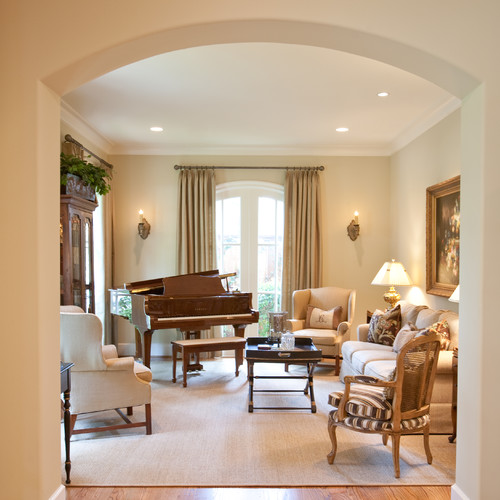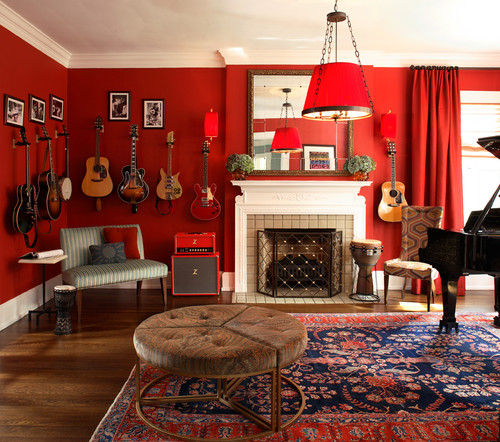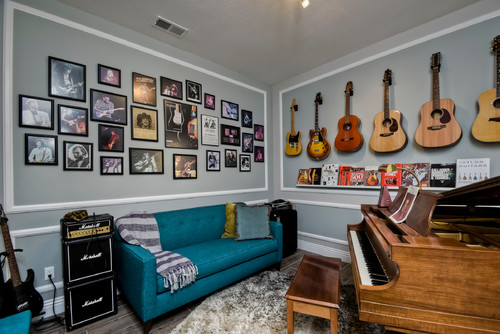Space To Jam: Does Your Home Need a Music Room?

Photo courtesy of Dillard Pierce Design Associates via Houzz
Once upon a time, spying a music room in someone’s home wasn’t a big deal. For some lucky folks, space for a grand piano, harpsichord, or other impressive instrument was a sign of wealth and class.
Of course, when the radio was invented and TV later came along, gathering around a spinet to croon a few tunes after dinner fell by the wayside. And so did music rooms.
But today, these melodic spaces are back and surging in popularity.
“I’ve generally seen music rooms as an amenity in large-scale condos,” says Marie Bromberg, a real estate agent with Compass in New York City. “And while I previously thought this was a waste of space, I’ve come around to believing music rooms are a great idea.”
Curious about this audio trendlet? Read on for more about music rooms, how to create this special space, and whether adding one can boost your home’s value.
What is a music room?
 Photo by Creative Touch Interiors
Photo by Creative Touch Interiors
Music rooms were originally a place for playing instruments, notes Steve Halpern, a real estate broker with Compass in New York City.
You can imagine a young child playing the violin for her grandparents to enjoy.
But more recently, music rooms have “become more complex,” says Halpern. “It’s more of an adult amenity.”
According to Robert Oleysyck, musician and design specialist, a music room is now a dedicated area “where people can enjoy prerecorded music with a stereo and speakers; play and practice instruments; or even record, produce, and mix their own tunes.”
And if the music room is properly tricked out, the space can serve all of these melodic functions.
Why are music rooms popular now?
 Photo by Dillard Pierce Design Associates
Photo by Dillard Pierce Design Associates
There are several reasons music rooms are popping up—starting with the quality of today’s tunes and technology.
“With the advent of iTunes and streaming, the quantity, quality, and diversity of music has never been more accessible,” explains Oleysyck. “And the equipment needed to properly enjoy music and create your own room has come down in price.”
The COVID-19 pandemic also made its mark on music rooms.
“People want more spaces in the home that can be used for leisure,” notes Halpern. “And some prefer having a music teacher come to them, rather than go to someone else’s house for lessons.”
The now-constant blur between home life and remote work also factors into the rise of music rooms.
“Millennials and Gen Xers have begun a lot of side hustles and gig work, which means they have varying schedules that allow for new hobbies like music,” says Bromberg.
The bottom line? High demand for music rooms is keeping pace with other luxe amenities, such as screening rooms and wine-tasting nooks.
How to create an affordable music room
Got extra space in your basement? Or maybe you’re willing to convert a walk-in closet for your jam sessions?
These are two options that won’t break the bank when it comes to putting in a music room. For decoration, Halpern suggests “rock posters, cool neon lights, or strobes, which are all inexpensive and can be super chill.”
And remember: You don’t need the best musical equipment right off the bat, says Oleysyck.
“Ultrahigh-end equipment can be extremely expensive, so do some research for the best quality options you can find within your budget,” he urges.
High-end music rooms
 Photo by Cindy Aplanalp & Chairma Design Group
Photo by Cindy Aplanalp & Chairma Design Group
If you have the space and money, you can really splurge with a grand piano, every type of drum, and soundproofing.
“Excellent speakers and tube amplifiers, like McIntosh Labs, take a music room to the next level,” says Halpern.
But even with the priciest equipment, you don’t have to lay out as much as you might think for acoustic treatments.
“Investing a few hundred dollars can go a long way to helping with a room’s acoustics,” says Oleysyck. “Treatments are available in decorative fabrics or custom-printed panels.”
What’s a music room’s return on investment?
 Photo by Nikki Klugh Design Group
Photo by Nikki Klugh Design Group
Not every homeowner is going to rock out on a drum set or listen to Bach for hours on fancy speakers, so the return on investment for a music room is in the eye (or ear) of the beholder.
“If resale is a concern, don’t spend too much on your music room,” suggests Oleysyck. “Keep the look and aesthetics minimal.”
A music room should fit in with your home’s overall style.
“This space can become something unique to show off in a high-end listing—it’s a luxury you don’t see all the time,” says Halpern.
But if the rest of the home is mellow—and your music room is insanely over the top—it’s likely not worth the extra expense if you plan to sell.
And Bromberg reminds us that with folks increasingly heading back to the office, the need for a home office may not be as critical.
“So set up a music room where the office was, and it’ll get just as much usage for families,” she says.
The post Space To Jam: Does Your Home Need a Music Room? appeared first on Real Estate News & Insights | realtor.com®.


